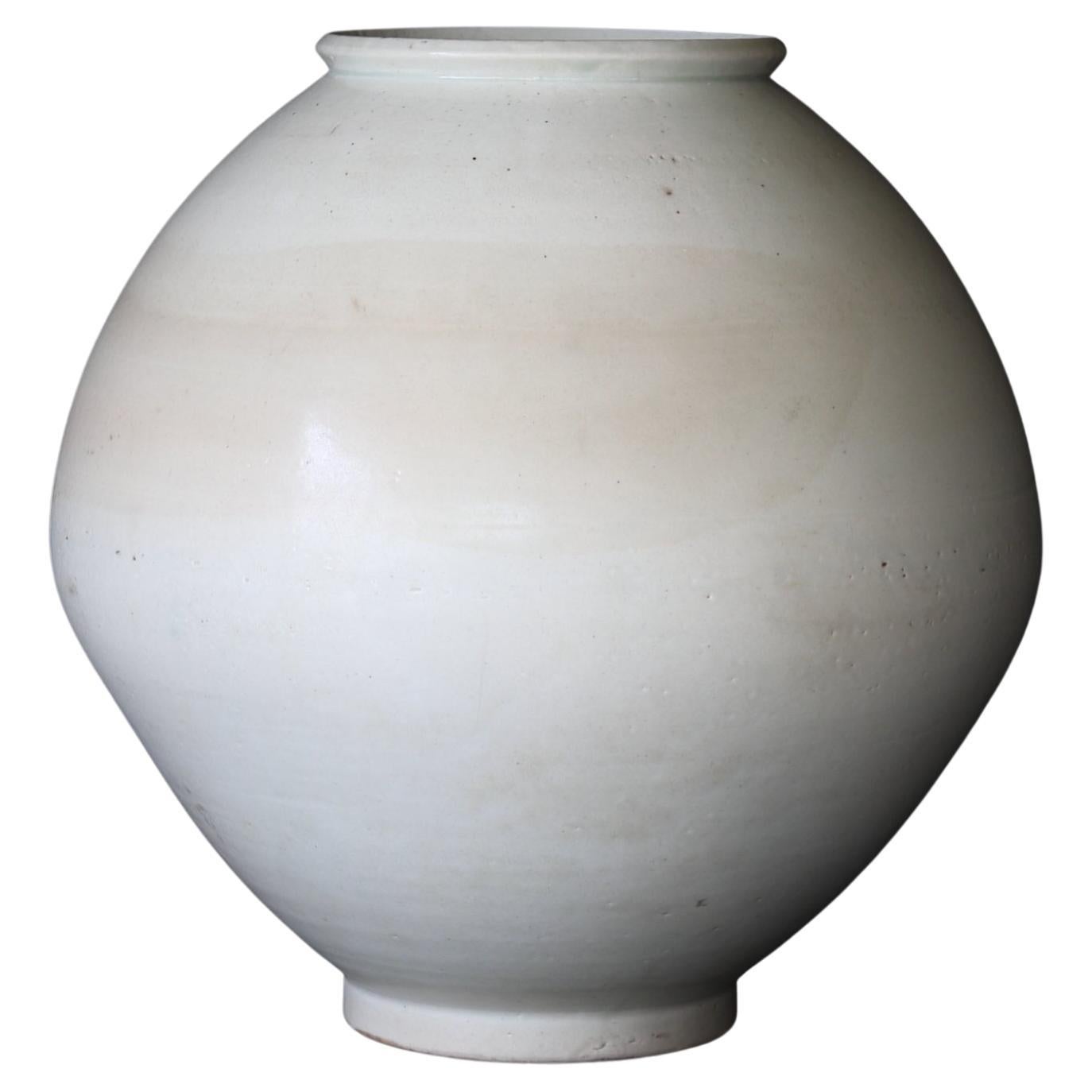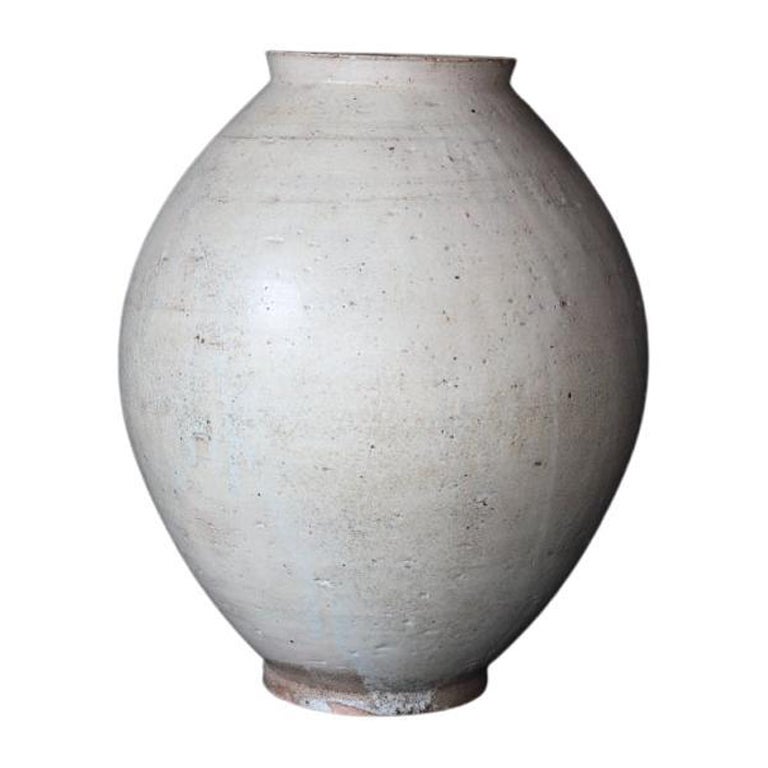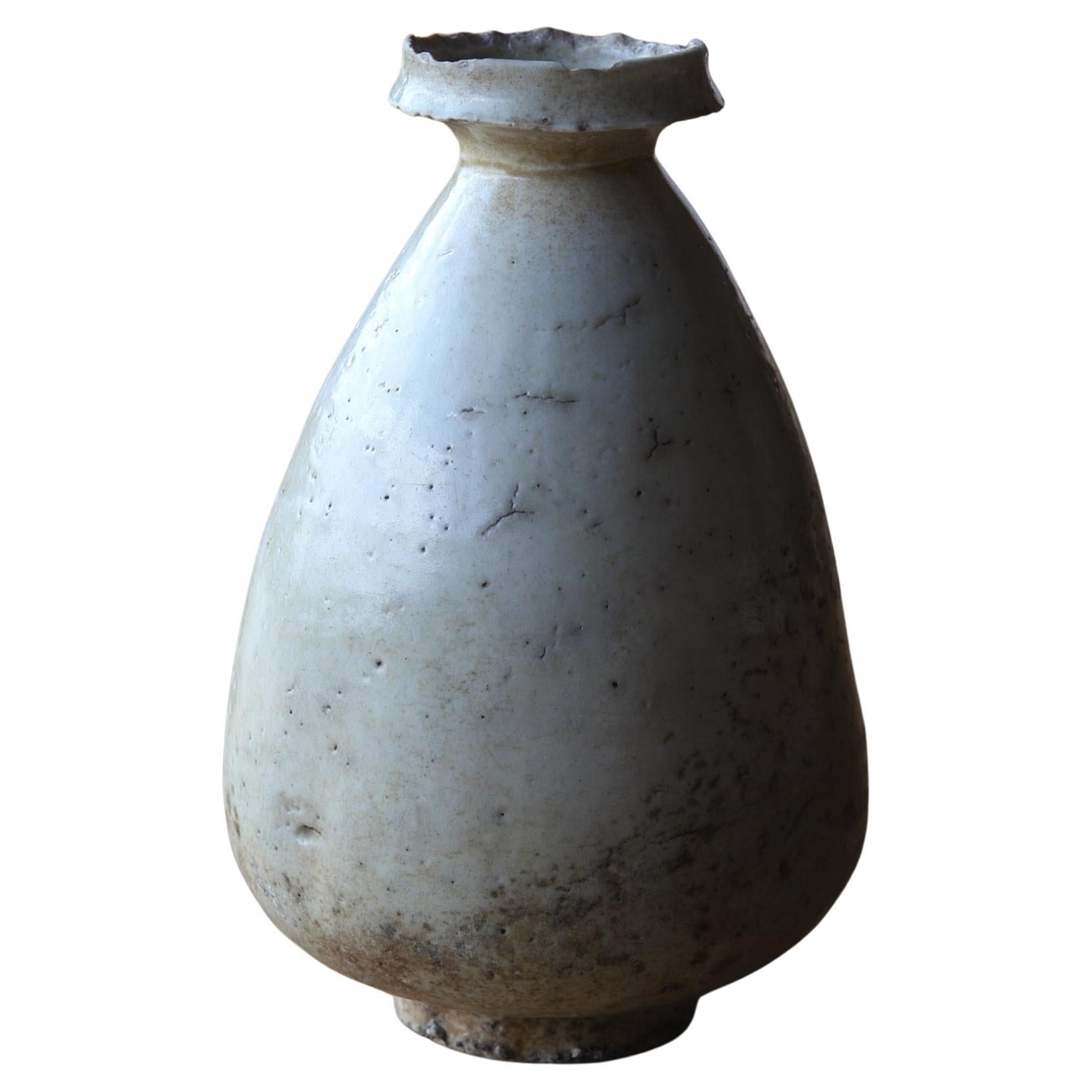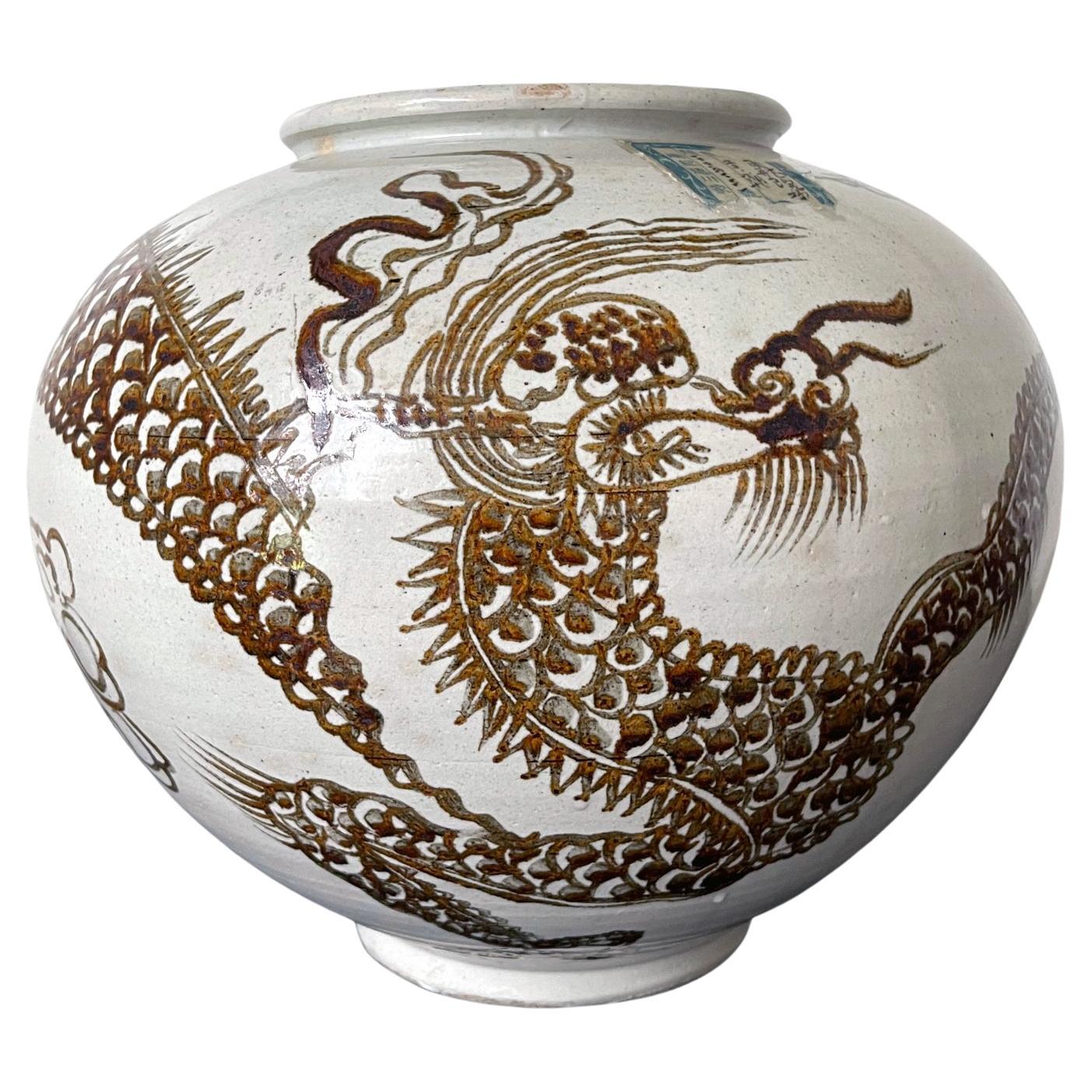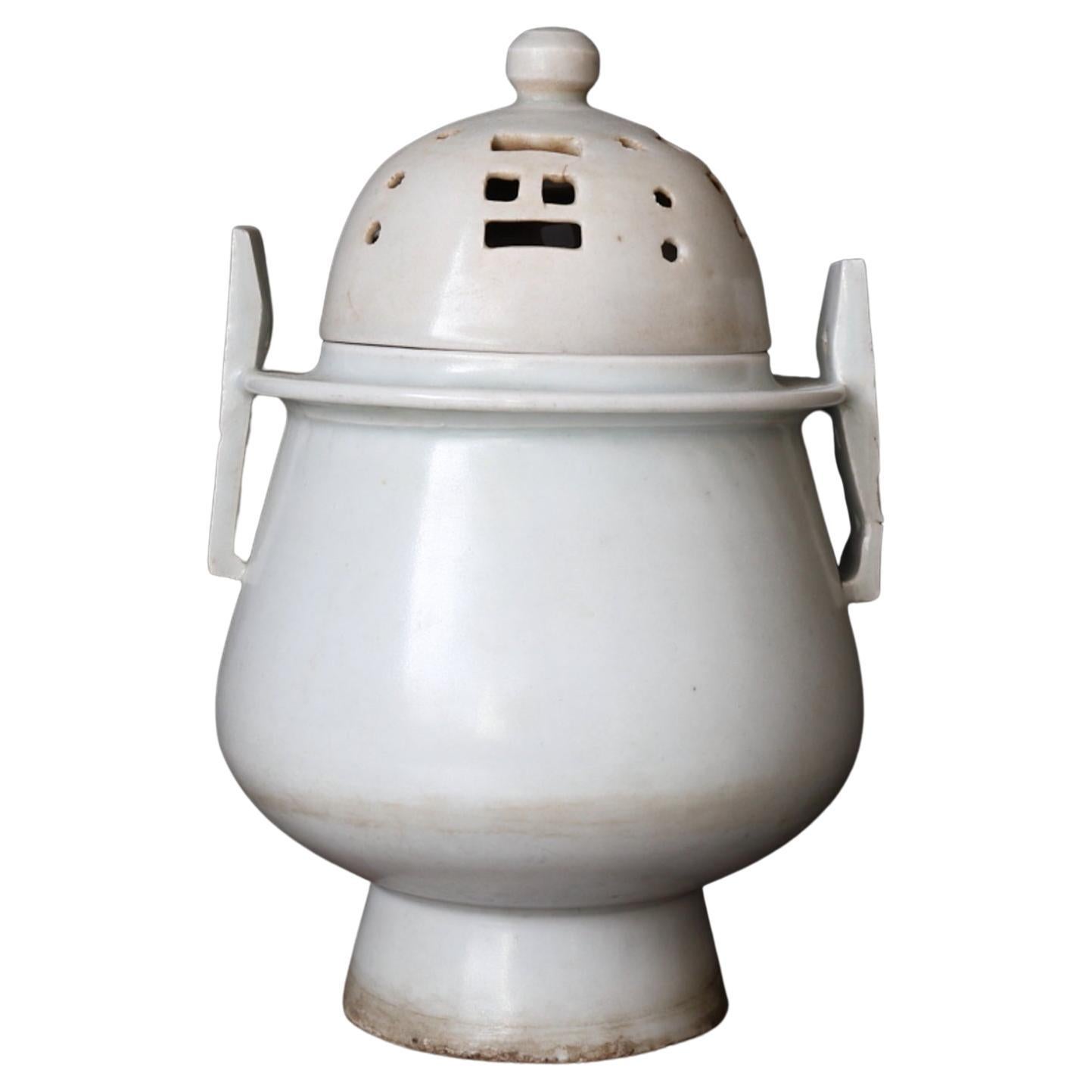Items Similar to Moon Jar 'Dalhanari', Lot3 / 17th Century / Korean Antiques / Joseon Dynasty
Want more images or videos?
Request additional images or videos from the seller
1 of 17
Moon Jar 'Dalhanari', Lot3 / 17th Century / Korean Antiques / Joseon Dynasty
About the Item
This is a white porcelain jar from the mid-Joseon period, also known as a "Talhunari" or "moon jar". During the Joseon Dynasty, which was strongly influenced by Confucianism, the purity of white porcelain was particularly prized in its artistic expression due to its Confucian sensitivity. The defining characteristic of white porcelain during this period was its pure white color, but there were many subtle variations in the white hues, with some being classified as milky white, snowy white, ashen white, and bluish white.
The term "Talhunari" means "moon jar" in Korean, and it refers to the large, round shape of the jar, resembling a full moon. It was named by Kim Whanki, a representative abstract painter of Korea. The soft, curving lines and sturdy body that seems to embrace the full moon give the jar both power and tranquility. This type of jar was produced in large quantities during the 17th century.
The white of the moon jar is not the pure white of early Joseon porcelain, nor the ashen white of mid-Joseon period, nor the bluish-white often produced at the official kilns. Generally, it is referred to as milky white, but not all moon jars are the same. In many cases, a range of different white hues can be found within a single vessel. Additionally, some moon jars may have yellowish spots caused by oxidation or incomplete combustion, or discoloration caused by the seepage of liquids.
Moon jars always exhibit different tones of white and subtly change over time, likely due to their organic composition. The variety of these changing white tones may be what attracts us to them.
This piece is in excellent condition, maintaining its pristine form with almost no damage. It has a rich, creamy white color. Moon jars are often made by separately shaping the upper and lower hemispheres and then joining them together because they are too large to be made in one piece on a potter's wheel. This method of joining was first used in the early Ming Dynasty (1368-1644) and is a highly effective way of making large Chinese jars. Most large jars made using this method have smooth trimming, so the connecting line in the center of the body is not visible. In contrast, the joining lines on Korean moon jars tend to crack or warp during firing, making it difficult to create a perfectly spherical shape like this piece. Due to this slight irregularity, most moon jars have a shape resembling a crescent moon rather than a full moon. However, this asymmetry adds to their beauty, creating a random and natural feel that evokes subtle changes and movements in the natural world.
This item comes with a purchase receipt from when the previous collector acquired it from an antique shop in the Taisho period. The paper is in poor condition and has some insect damage.
- Dimensions:Height: 16.93 in (43 cm)Width: 17.33 in (44 cm)Depth: 17.33 in (44 cm)
- Materials and Techniques:
- Place of Origin:
- Period:
- Date of Manufacture:1392-1910 CE
- Condition:
- Seller Location:Kyoto-shi, JP
- Reference Number:1stDibs: LU7673234103732
About the Seller
No Reviews Yet
Vetted Seller
These experienced sellers undergo a comprehensive evaluation by our team of in-house experts.
Established in 2012
1stDibs seller since 2022
- ShippingRetrieving quote...Ships From: Kyoto-shi, Japan
- Return PolicyA return for this item may be initiated within 2 days of delivery.
More From This SellerView All
- Moon Jar 'Dalhanari' - Lot2 / 17th Century / Korean Antiques / Joseon DynastyLocated in Kyoto-shi, KyotoThis is a white porcelain jar from the mid-Joseon period, also known as a "Talhunari" or "moon jar". During the Joseon Dynasty, which was strongly influenced by Confucianism, the purity of white porcelain was particularly prized in its artistic expression due to its Confucian sensitivity. The defining characteristic of white porcelain during this period was its pure white color, but there were many subtle variations in the white hues, with some being classified as milky white, snowy white, ashen white, and bluish white. The term "Talhunari" means "moon jar" in Korean, and it refers to the large, round shape of the jar, resembling a full moon. It was named by Kim Whanki, a representative abstract painter of Korea. The soft, curving lines and sturdy body that seems to embrace the full moon give the jar both power and tranquility. This type of jar was produced in large quantities during the 17th century. The white of the moon jar is not the pure white of early Joseon porcelain...Category
Antique 17th Century Korean Antiquities
MaterialsCeramic, Porcelain
- Moon Jar / Korean Antique vase / Joseon Dynasty / 18th CenturyLocated in Kyoto-shi, KyotoIt's a wonderful moon jar. It is a rare size that is suitable for the alcove of a Japanese tea room. It is shaped at once without connecting the uppe...Category
Antique 18th Century Korean Antiquities
MaterialsCeramic
- White Porcelain Vase / 17th Century / Korean Antiques / Joseon DynastyLocated in Kyoto-shi, KyotoThis product is a white porcelain bottle from the Joseon Dynasty. People in those days used bottles like this to make soap from waste oil. With use, the porcelain frayed and curle...Category
Antique 17th Century Antiquities
MaterialsCeramic, Porcelain
- White Porcelain Incense Burner / Korean Antique / Joseon Dynasty/1392 - 1897 CELocated in Kyoto-shi, KyotoThis incense burner presents the characteristics of a typical Yi Dynasty Joseon Dynasty incense burner with a body that rises smoothly from the base, openworked ears and a semi-circu...Category
Antique 17th Century Korean Antiquities
MaterialsCeramic
- Bottle Buncheong Ware / 15th Century / Korean Antiques / Joseon DynastyLocated in Kyoto-shi, KyotoPowder blue celadon ware is a type of porcelain made in Korea during the first half of the Joseon dynasty, mainly in the 15th century. It was made by applying a fine white slip over ...Category
Antique 15th Century and Earlier Korean Antiquities
MaterialsCeramic, Porcelain
- White Porcelain Moon Jar, Joseon Dynasty / 1392-1897Located in Kyoto-shi, KyotoThis is a white porcelain jar from the mid-Joseon period, also known as a "Talhunari" or "moon jar". During the Joseon Dynasty, which was strongly influenced by Confucianism, the purity of white porcelain was particularly prized in its artistic expression due to its Confucian sensitivity. The defining characteristic of white porcelain during this period was its pure white color, but there were many subtle variations in the white hues, with some being classified as milky white, snowy white, ashen white, and bluish white. The term "Talhunari" means "moon jar" in Korean, and it refers to the large, round shape of the jar, resembling a full moon. It was named by Kim Whanki, a representative abstract painter of Korea. The soft, curving lines and sturdy body that seems to embrace the full moon give the jar both power and tranquility. This type of jar was produced in large quantities during the 17th century. The white of the moon jar is not the pure white of early Joseon porcelain...Category
Antique 18th Century Korean Ceramics
MaterialsCeramic, Porcelain
You May Also Like
- Korean Silla Dynasty Footed Jar, circa 6th Century, KoreaLocated in Austin, TXA charming Korean high fired gray pottery stoneware footed vessel, Three Kingdoms Period, Silla Kingdom, circa 6th century. The vessel of traditiona...Category
Antique 15th Century and Earlier Korean Antiquities
MaterialsPottery, Stoneware
- Korean Ceramic Moon Jar with Dragon Joseon DynastyLocated in Atlanta, GAOn offer is a large Korean ceramic storage jar (hangari) with white glaze and iron red underglaze dragon design. The globular shaped jar derived its form from the Moon Jar of the ear...Category
Antique 18th Century Korean Archaistic Ceramics
MaterialsCeramic
- Korean White Glazed Jar, Joseon Dynasty, 18th Century, KoreaLocated in Austin, TXA sublime Korean white glazed porcelain globular jar, Joseon Dynasty, 18th century, Korea. The squat jar is heavily potted, with a globular body, very short neck, and wide mouth r...Category
Antique 18th Century Korean Ceramics
MaterialsPorcelain
- Antique Korean Porcelain Peony Jar Joseon DynastyLocated in Atlanta, GAA Korean white porcelain jar with underglaze blue painting of large peonies with leaves circa second half of 19th century, Joseon Dynasty. Considered associated with Punwon-ri kilns ...Category
Antique Late 19th Century Korean Other Ceramics
MaterialsPorcelain
- Antique Korean Porcelain Peony Jar Joseon DynastyLocated in Atlanta, GAA Korean white porcelain jar with underglaze blue painting of large peonies with leaves circa second half of 19th century, Joseon Dynasty. Considered associated with Punwon-ri kilns ...Category
Antique Late 19th Century Korean Other Ceramics
MaterialsPorcelain
- Korean Ceramic Storage Jar Joseon DynastyLocated in Atlanta, GAA Korean ceramic storage jar circa 18th century of Joseon Dynasty. The jar is of a characteristic form with a bulbous upper body that tappers with a gra...Category
Antique 18th Century Korean Other Ceramics
MaterialsCeramic
Recently Viewed
View AllMore Ways To Browse
Retro Blue And White China
Japanese Imari Large
Japanese 18th Century Antique
Chinese 18th Panel
Imari Porcelain Signed
Asian Dog
16th Century Chinese
Meiji Red
Hand Painted Gold Imari
Chinese Flower Scroll
18th C Chinese Furniture
Famille Rose Export
Arita Hand Paint
Famille Rose Chinese Export
Hand Painted Japanese Box
Antique Red And White China
Japanese Wooden Paintings
Chinese Qing Ceramic
